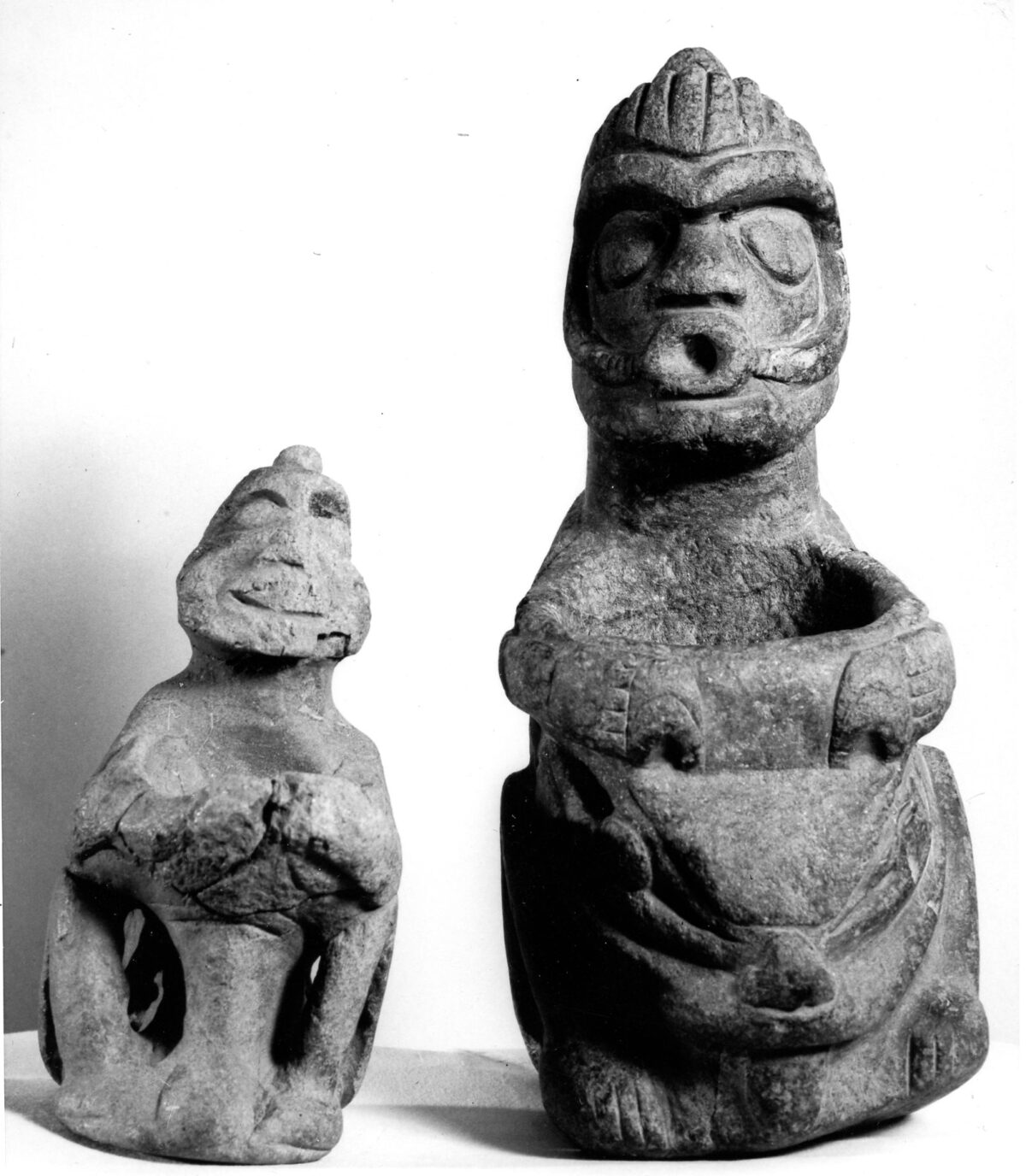Part 1. Victoria to Sooke.
One of things I find fascinating is how humans have represented themselves in ancient times. In S. W. British Columbia and N. W. Washington State, stone seated human figurine bowls have been of most interest in this regard (Duff 1956; 1975; Carlson 1983; Keddie 1983; 2003; Wright 1991; Hanna 1996). These stone figures have been used in various kinds of rituals that will allow us to potentially observe regional differences and diffusion of cultures in the past. All cultures are influenced by their neighbours and these objects are one of the puzzle pieces that will allow us to reconstruct some of those ancient patterns of connection.
The finding of most of these stone figures has been a result of random occurrences, and not of controlled archaeological excavations. Few have been found in a datable context but most appear to be older than 1700 years ago. Those that have been found in known ancient village deposits, will in the future, be subject to a date after which they were made, if the bottom of the deposits are dated. Unless, of course, an Indigenous person, long ago, found a thousand-year-old object and incorporated it into their own culture.
I will present, in a series of articles, more details on some of these fascinating objects. This may help find and return some figures that have left the country.
The Gorge Bowls. DcRu-87:1 and DcRu-87:2.
Two seated figurine bowls (Figure 1) were found by Mrs. F.L. Alexander while digging in her rose garden at 2858 Inlet Avenue, Saanich, on the north side of the Gorge Waterway. The find was reported in the Vancouver Sun on September 28, 1960. Don Abbott and John Sendy of the (then) Provincial Museum recorded the stratigraphy around the location where the bowls were found (Figure 2). They were originally about .20-.30 meters below the surface and lay in a concentration of yellow ash below the top soil. The figures would have been used in some ritual activity. It has been speculated that they may have been owned by a “shaman” and cremated and buried after the persons death.
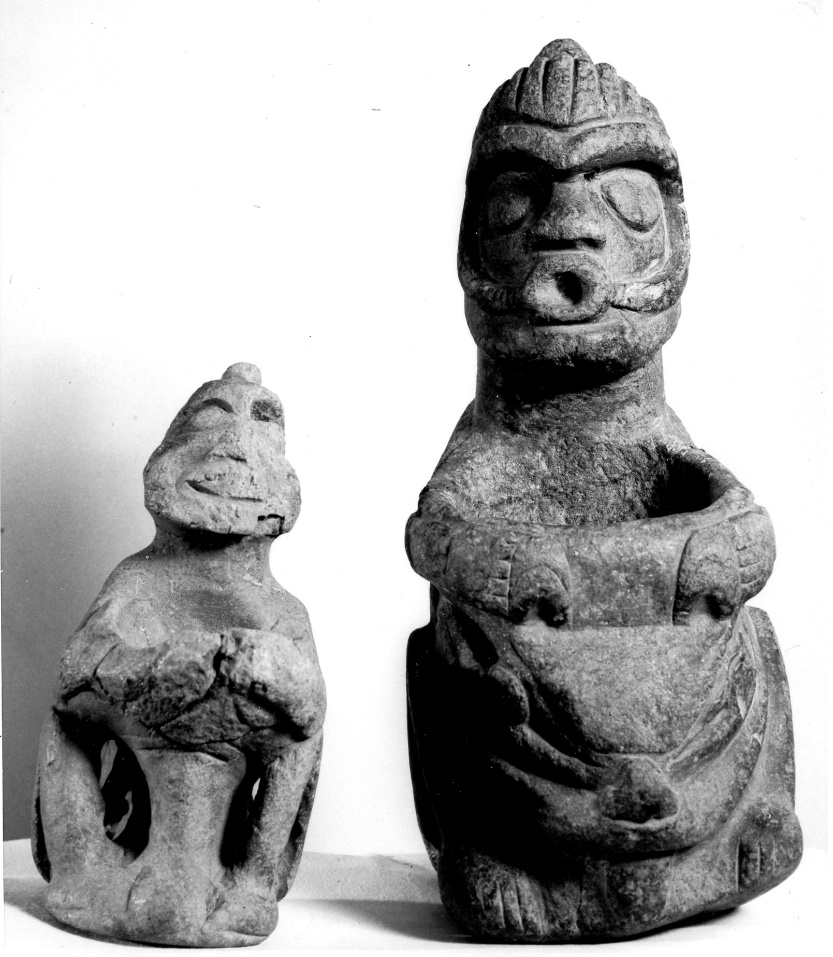



The stone figures were purchased from Mrs. Alexander by the late Edith Cross of Sydney and later owned by her son R. E. Bevan Gore-Langton of Victoria. They were sold to, antiquities dealer Howard Roloff, who sold the larger figure, DcRu-87:2, to a U.S. purchaser George Terasaki. The larger figure was in another private collection and then donated as part of the Eugene and Clare Thaw Collection of American Indian Art to the Fenimore Art Museum where it is recorded as object I.D. TO766. It is not known how the smaller figure was removed from Canada. In 1992, it was owned by Steven S. Muchnick & Eric C. Milliren of San Francisco.
A controversy arose regarding DcRu87:2 and another stone bowl going out of the Country. This is outlined in the following references: Vancouver Sun, Dec. 6,1983. The midden, Journal of the Archaeological Society. 15(5): 2, 1983. 16 (1):1-3, 1984; 16(3):9, 1984; 16(4):2-3, 1984.
The RBCM made a copy of the original artifact DcRu-87:1. Accession No. 1983-86. DcRu 87:1 Cast. Measurements: 22cm high x 10cm wide x 13.5cm deep. (see Duff, 1975, pp.55, 62, 172 (Duff Nos. 30 and 32).
Description.
DcRu-87:1. There is a concavity in the base that measures 6.2cm from front to back and 4.8cm across and 2.5cm in depth at centre (figure 6). Two holes in the base were likely made to fasten the figure on to a wooden post as demonstrated in figure 6. The figure shows a human with their hands around the top of bowl with an extension going down between its raised sitting legs with a slotted space between the bowl extension and the legs. There is no human or zoomorphic face on the front of the bowl which is common on other seated figures. The figure has distinct rib features on each side of its body. Its face is damaged and it has what is most likely a representation of a top knot of hair on its head. A newt (based on head shape) or lizard, is carved along the spine on the back of the figure. It extends from the lower lumbar area to the top of the shoulders. There is evidence of burning on the figures.
Description.
DcRu-87:2. Measurements: 37cm high x 14cm wide x 21.3 cm deep. This is a seated human with their arms around most of the top of a bowl. Its bent legs encase the bowl. A distinct rattlesnake extends down the back of the spine from the upper lumbar area to the top of the back of the head, where the rattle of the snake is located. On the front of the bowl is a snake head with a protruding tongue. The fsnake face and feet can be seen from the bottom in figure 4.
There are rib patterns on both sides of the body. The face has nearly round eyes with an open mouth that might represent singing or speaking. A ridge forms around the eyebrow and extends on both sides to the mouth. This could be a snake feature or represent part of a headdress which spans across the front of the head. A protrusion from the top of the head may be an extended tied top knot of hair.
The raw material is a steatite-like material but has never been confirmed by a profession analysis. If it is steatite, it must have come from the Interior, which is also suggested by the fact that rattle snakes only occur in the Interior.
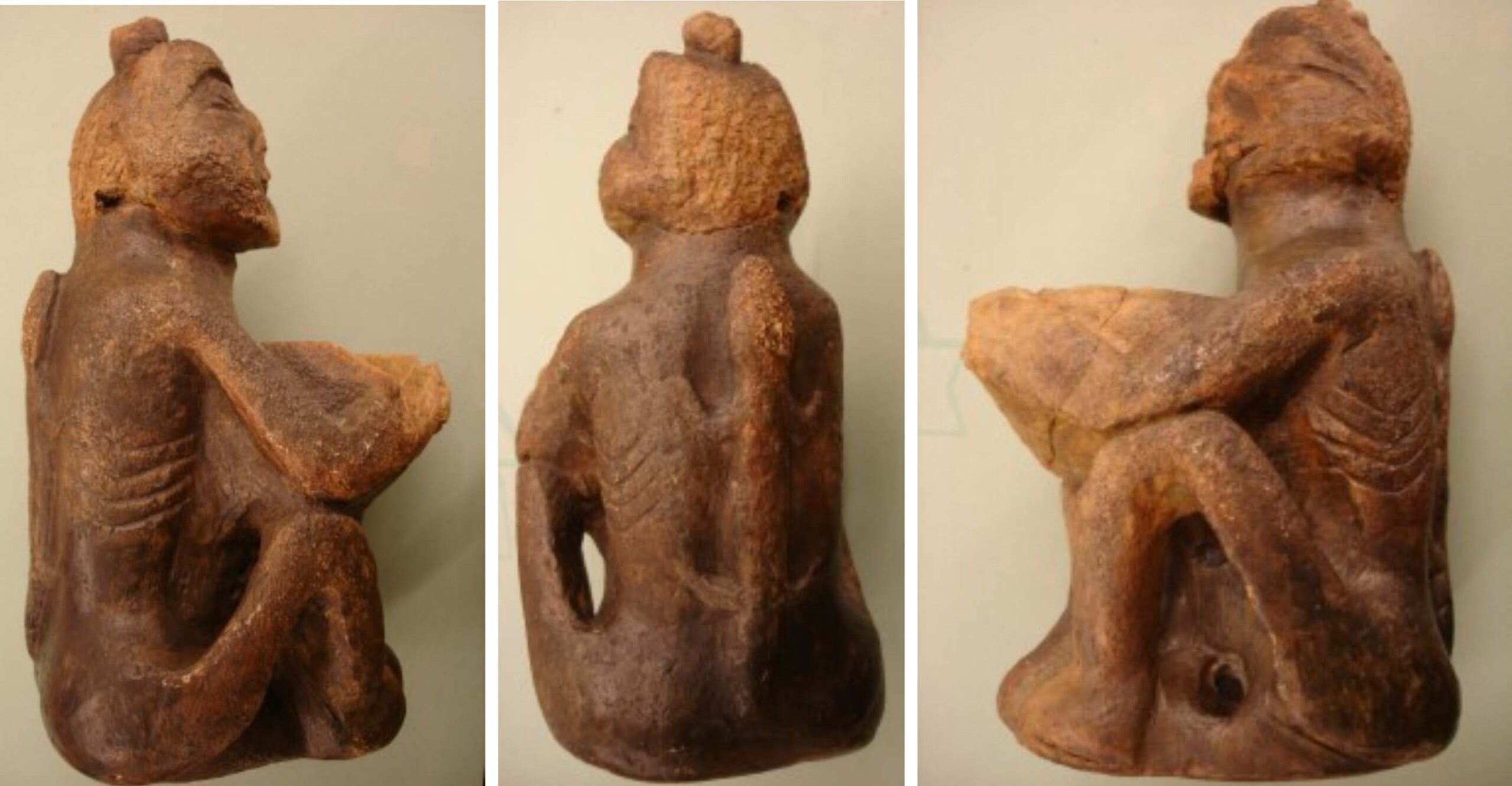
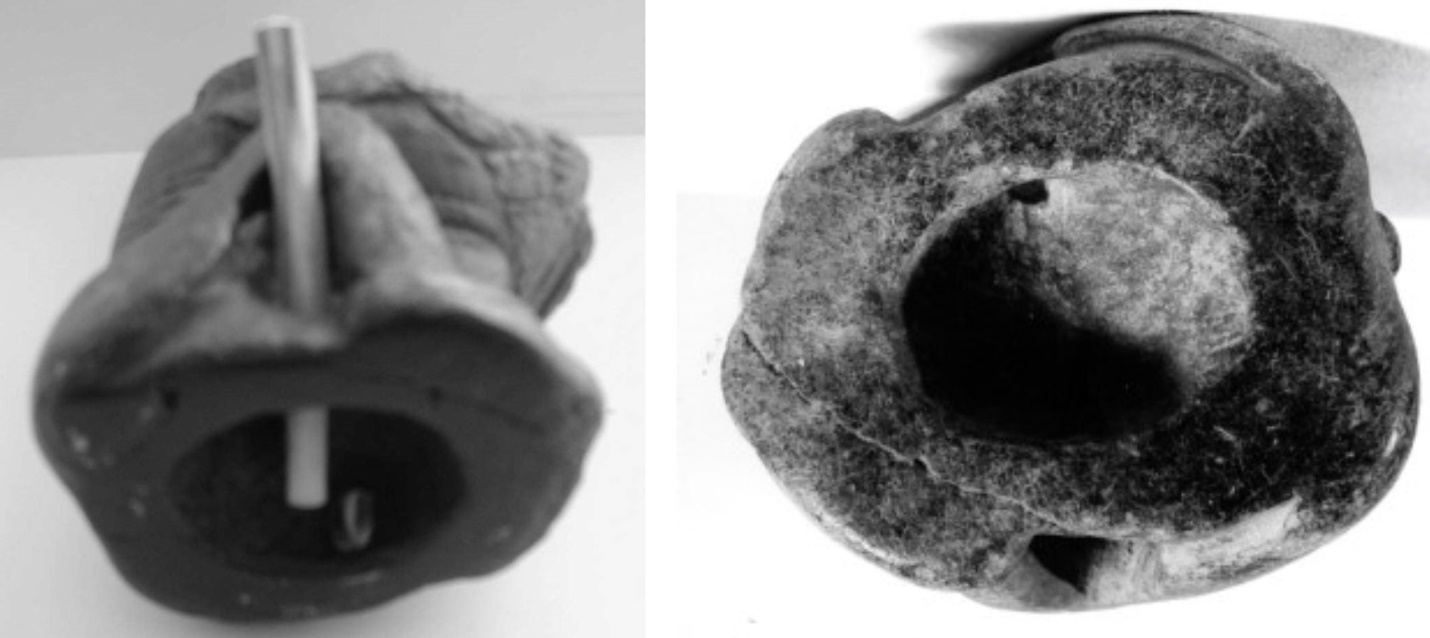
These figures have been previously shown in: Keddie 2003 (p. 168) and Duff 1975 ( DcRu-87:1. No, 32. p. 172; DcRu-87:2 No. 30. p. 53-55; 172).
The William Head bowl
This figure was found at the William Head Quarantine Station in 1906, by Dr. A. T. Watt, who was the Superintendent of Quarantine Services in Victoria. Wilson Duff mistakenly refers to the find location as Albert Head (Duff 1956). The mistake was made because at the time of Duff’s writing the artifact was still in the private collection of William Newcombe whose father’s notes (see below) were not available at the time. Because the record referred to the “Quarantine station” it was assumed to be Albert Head which was a Quarantine station from 1882-1892, but not when the artifact was found. The large Newcombe collection of Ethnographic and Archaeological material was donated to the Provincial Museum in 1961.
Charles Frederick Newcomb’s note of August 18, 1909 describes this artifact:
“Stone mortar found at William’s Head Quarantine station by Dr. Watt in 1906, at a depth of about one foot below the surface. Of a brown fine-grained stone, much weathered, and with diagonal fissures, which apparently are joints containing calcite or some other mineral of light colour.
The stone is carved to resemble a seated human figure, the chest & abdomen are hollowed out to form the basin of oval shape the edges of which are formed by the arms of the figure.
The head is 5 inches in height, above the left eye is a ridge with four vertical incised lines, perhaps in imitate a coiled bark head-dress. That on the right side has weathered away. Back of the head is a pit with which 4 holes communicate, apparently for the passage of a suspending cord. Below the basin are two narrow pits. Total height 15 inches, Greatest width 6 inches”.
After the about typed script Newcombe hand wrote: “See Archaeol. of Gulf of Georgia by Harlin I. Smith, Jessup Exp. Expl. Fig. 183 + 190”. (Newcombe 1909).
The William Head figure was given the old number of X109 and a new number in 1961. When the Museum number system became too large a “10” was added to old numbers. This is how the later “old museum number” 10109 was created.
The location was not given a specific Archaeological site number, resulting in the “Y” approximate location being given in the Borden numbering system as DcRv-Y:2. An oversize print of this artifact has “William Head” “615” which is a Newcombe collection number. In Newcombe’s register of Negatives Ec 421-V1/61 (See Ec. 389 & Ec. 498) the description is: “Stone carving wm Head Dr. Watt X109”.
Description
The raw material is a hard metamorphic stone which has not undergone a profession identification. The human face has a broad mouth extending across the front, a wide flat nose and large inset eyes with raised lenticular pupils inside (Figure 7). The figure is heavily weathered but it appears to have a head-dress-like item on its head, which can be best be seen in the side view. The figure is in a vertical but sitting-like position. The arms extend downward forming the rim of the basin. The indented basin area includes the whole chest area of the figure. This would not hold water when standing up and the rounded back would indicate it was not laid on its back. It does not stand up straight on its current bottom (Figure 8). Below the basin is a flat vertical surface with two drilled holes (Figure 9). The holes are 22-24m in depth and 4.5cm apart. I would suggest that there is a missing lower part of this figure, that was attached to the front with pegs. The missing attachment may not necessarily have been made of stone.
It is clear that this heavy artifact was suspended in the air or tied to something to hold it in place. There are four holes drilled in the top of the head (Figure 9). The evidence shows that the bridge between the first two holes broke through, resulting in two more suspension holes being drilled. We cannot rule out that decorative items may have also been added to the top of the head and held in place by being tied to the bridge between the holes, but it is not likely these attachments would break the stone bridge between the holes. This figure has been previously shown in: Duff 1956. (No. 39. p.141 & p.37. Pl. 14 H).
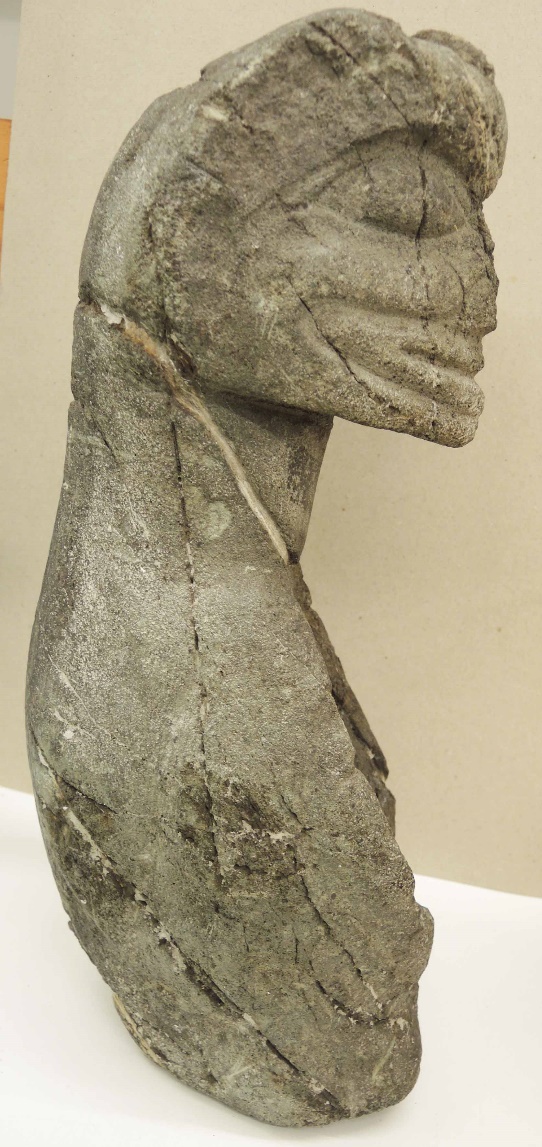
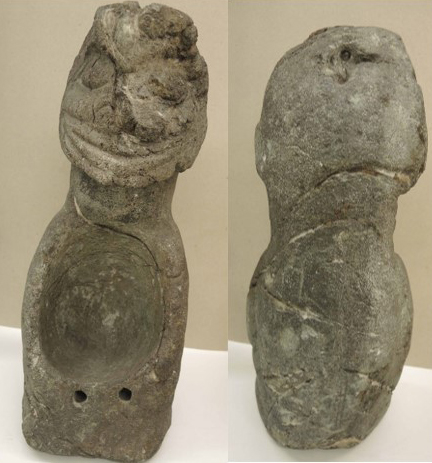

The Whiffen Spit Bowl
This is the smallest of the seated figure bowls found on Vancouver Island. It’s appearance has more in common with bowls from the Interior and lower Fraser River. It is made of steatite that is found in the southwestern Interior of the Province.
Very few of the stone figures have a specific site provenance. This one was recovered by Audrey Pears of Sooke after digging in her garden where a large tree had previously uprooted the ground 30 meters from an archaeological shell midden, DcRw-2 (Figure 11). The site is located on a small bluff above Whiffen Spit west of Victoria. The roots had pulled up and exposed a scattered rock pile with the figure around it. The context of the find suggests that the figure was ritually buried under a rock cairn.
Description
This is a kneeling human figure that is highly polished (Figure 10) . It is unique in having a more stylized human face with proportionally large inset eyes and a phallic-like extension on the top of its head. Other figures from the lower Fraser River that have similar extensions on their heads that are clearly snakes. The downward arms of the figure merge into the sides of a bowl located above the kneeling legs
The figure was sold to the late Edith Cross of Saanich. It was bought by another person and exported out of Canada in 1982 and sold at Sothebey’s auction. In June 2007, it was again sold at an auction in Francisco. Its present location is unknown.
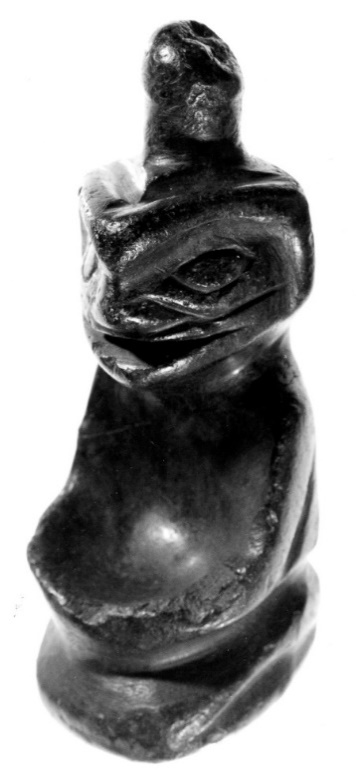
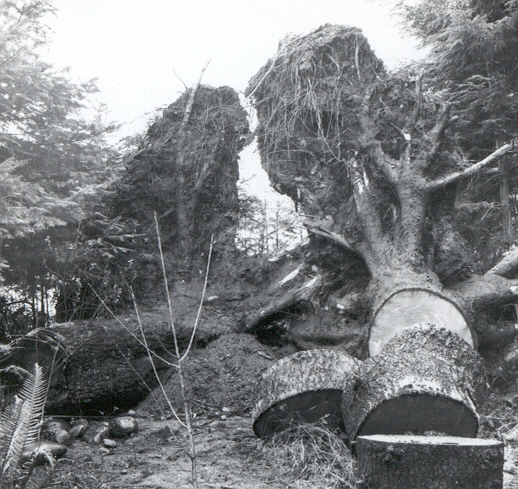
References:
Carlson, Roy. 1983. Change and Continuity in Northwest Coast Art. In: Indian Art Traditions of the Northwest Coast, Ed. Roy Carlson, Archaeology Press, Simon Fraser University, Burnaby, B.C., pp. 197-205.
Duff, Wilson. 1956. Prehistoric Stone Sculpture of the Fraser River and Gulf of Georgia. In: Anthropology in British Columbia, No. 5, 1956, British Columbia Provincial Museum, pp.15-151.
Duff, Wilson. 1975. Images Stone B.C. Thirty Centuries of Northwest Coast Indian Sculpture. Hancock House Publishers.
Hannah, John. 1996. Seated Human Figure Bowls: An Investigation of a Prehistoric Stone Carving Tradition from the Northwest Coast. Masters Thesis, Archaeology, Simon Fraser University.
Keddie, Grant. 1983.Ritual Bowls of the Salish Indians: Some Theories. The Midden, Journal of the Archaeological Society of B.C., 14:6:2-4.
Keddie, Grant. 2003. A New Look at Northwest Coast Stone Bowls. In: Archaeology of Coastal British Columbia. Essays in Honour of Professor Phillip M. Hobler, pp. 165-174. Edited by Roy L. Carlson. Publication Number 30, Archaeology Press, Simon Fraser University.
Newcombe, Charles Frederick. 1909. Notes Add. Mss. 1077. Newcombe Family papers. Subject files, Series B: Miscellaneous.
Wright, Robin. (Ed.)1991. A Time of Gathering. Thomas Burke Memorial Washington State Museum. Monograph 7. Native Heritage in Washington State. Burke Museum, Seattle.
